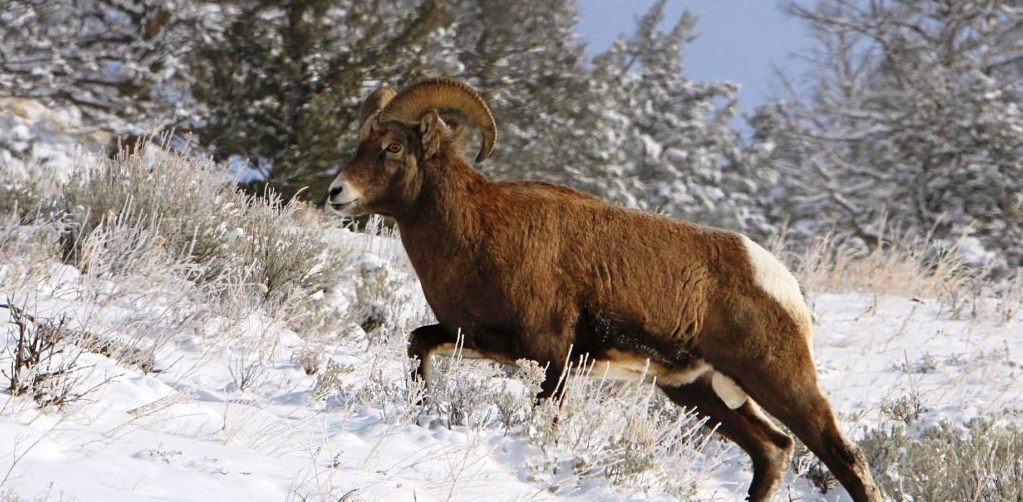As a part of a multi-year plan to reintroduce bighorn sheep into areas of the Madison Mountain Range east of Ennis, Montana, the Montana Department of Fish, Wildlife and Parks plans to join researchers at Montana State University (MSU) this winter to relocate approximately 25 bighorns. The project is tentatively scheduled for December or January, pending snow conditions and sheep counts.
Should the relocation occur, family groups will be moved from a herd of healthy bighorns wintering north of Quake Lake. The sheep will be introduced into the Wolf Creek drainage, some 10 to 12 air miles north of the capture site, using a method known as drop-net capture. A large net is suspended over a bait site and can be released in order to capture entire family groups.
“It’s a really nice way of translocating because you can get entire social groups,” said Robert Garrott in a September 20, 2017 presentation at the Museum of the Rockies as a part of the Science Inquiry Lecture Series. Garrott, who designed the drop-net mechanism, is a professor in MSU’s Department of Ecology and is a leading researcher for several bighorn sheep research initiatives.
By capturing family groups, Garrott explained, biologists are able to move sheep that are already familiar with each other, which means they might be less likely to return to the capture site seeking their native range and herd.
This initiative, as well as other translocation projects and monitoring efforts, comes in response to historic population declines in bighorn sheep throughout the state due to a combination of market hunting in the early 20th century, competition with livestock, and disease outbreaks that continue today.
Flash back to Idaho in February of 2002:
A small group of volunteers and Fish and Game staff cheered as 20 bighorn sheep raced up the hillside of their new home in Hells Canyon earlier this week.
Once the bighorns were away from their human handlers, they seemed unfazed by their strange adventure that began along the bluffs of the Missouri Breaks in Montana.
Using helicopters fitted with net guns, Montana capture crews caught up with the sheep early on the morning of February 19, 2002. In order to capture a wild bighorn, the helicopter tracks a sheep, then the gunner shoots out a net to capture the animal. Another person jumps out of the helicopter and on top of the sheep, hobbles and blindfolds it. The sheep is hauled into the helicopter and carried to where a veterinarian and another crew take health samples and load the sheep in a trailer. Once 20 ewes and rams were captured, the Idaho Fish and Game crew drove the sheep for 15 hours to reach Hells Canyon. There the sheep were unloaded, carried to jet boats, hauled up the river, and finally released on a beach in Hells Canyon.
“It went amazingly smoothly,” said Frances Cassirer, Senior Wildlife Research Biologist for Idaho Fish and Game.
“It was just great,” exclaimed Herb Meyr, a long time member of the Foundation for North American Wild Sheep (FNAWS). “They went right up into the steep country, kind of settled into the country where you would think there would be bighorn sheep.”
In fact, bighorn sheep once thrived in the craggy cliffs and steep hillsides along the Snake River. “They were more common than elk and certainly during some periods, more common than deer,” Cassirer said. When pioneers settled the region in the 1800s, their domestic sheep brought in diseases that were fatal to the wild bighorn sheep. By the turn of the century, not a single bighorn roamed the rocky canyon.
Disease continues to be the biggest threat to the survival of bighorns. “We don’t really understand the whole dynamic of pastuerella, pneumonia and bighorn sheep,” Cassirer said. “But we are very concerned, because that’s been our biggest problem in restoring of bighorn sheep to Hells Canyon.” Because of this concern the bighorns from Montana were released at a site where domestic sheep had not grazed in many years and no other bighorns occupied the area.
This latest bighorn transplant is part of a larger program. Several years ago, Idaho Fish and Game, Oregon, Washington and Foundation for North American Wild Sheep (FNAWS) created a multi-state project to reintroduce bighorns into Hells Canyon. The project supports research on diseases, habitat and putting more sheep back in the canyon.
“The reason we do transplants into Hells Canyon is to start new herds. We are speeding up the natural colonization of bighorn sheep in the canyon,” Cassirer said. There are currently 800 sheep in the canyon split up into 15 herds. This latest group of 20 will be the foundation for the sixteenth bighorn herd in Hells Canyon. “We’d like to sbighorn sheep be restored to their former abundance. Right now we’re shooting to get 2,000 sheep in the canyon over the next five to 10 years.”
“I’m proud of the whole Hells Canyon Initiative,” says Herb Meyr. “It’s been worthwhile raising money for it and it takes a lot of money to transplant sheep. There’s a lot of effort that goes into it, and it makes you proud to be associated with it, the organization and Fish and Game.”
Frances Cassirer, who has been the primary wildlife biologist on this project for several years, sees history coming full circle with this latest transplant. “First there were bighorns here, then there was a domestic sheep ranch. Then the Forest Service acquired the land and now we’re restoring bighorn sheep.”
Photo courtesy of the U.S. National Park Service.

